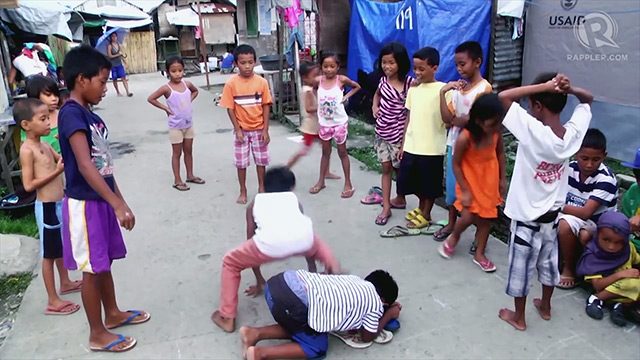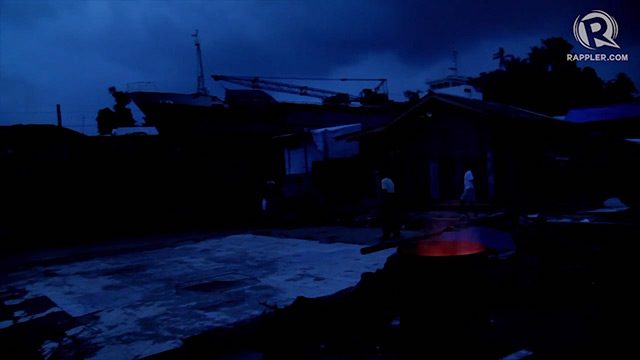SUMMARY
This is AI generated summarization, which may have errors. For context, always refer to the full article.

TACLOBAN CITY, Philippines – Surrounded by water, makeshift houses stand on stilts in the seaside community of Anibong, Tacloban City, a year after Super Typhoon Yolanda (Haiyan) triggered waves that swept this village away and left thousands dead.
Here, 48-year-old Elma Delingol feels nervous every time the state weather bureau reports even a low pressure area, a potential storm.
Immediately, she packs her clothes and braces for evacuation – unlike hundreds of residents who once refused to leave their homes even if Yolanda was a super typhoon.
“Hindi maialis sa aming kaisipan ang Yolanda (We can’t remove Yolanda from our minds),” Delingol said.
Like Delingol, thousands of Yolanda survivors remain exposed to the risks they faced on November 8, 2013, when Yolanda hit the Philippines. A major reason, according to an expert, is that the government has not implemented any systemic change to prevent another Yolanda from killing thousands again.
In an interview with Rappler, Ateneo School of Government dean Tony La Viña said: “There’s no structural change, no policy change, and no change in terms of reduction of physical risks. If Yolanda happens tomorrow, are the people safe? They’re not safe. They have no place to go.”
‘Is there rehabilitation?’
La Viña added: “This is not rhetorical, but the question is, is there any rehabilitation going on? There is, but I think it’s quite minimal one year after, especially for the houses, for permanent settlements for people.”
Data from the Tacloban government show up to 3,000 families, or 14,100 Yolanda survivors, live in danger zones in this city alone.
Across the Philippines, the government needs to move more than 200,000 families, or 940,000 people, away from danger zones, according to the office tasked to oversee post-Yolanda rehabilitation efforts.
Rehabilitation Secretary Panfilo Lacson himself said building permanent houses for Yolanda survivors should have been faster. It is, after all, the “most tangible” sign of recovery,” Lacson told Rappler.
His office said 1,252 of the needed 205,128 permanent housing units, or less than 1% of the required houses, have been completed.
Leading the town worst hit by Yolanda, Tacloban Mayor Alfred Romualdez explained, “Wala kasing paglilipatan eh (We have nowhere to move them to).”
He said he is now building a 400-hectare “township” in the northern part of Tacloban to accommodate more than 14,000 Yolanda survivors in Tacloban who need homes away from danger zones.
‘If Yolanda happens tomorrow…’
The problem, however, goes beyond moving Yolanda survivors away from danger zones.
La Viña said the government has failed to adopt “a clear land use plan.” He explained that the challenge in disaster-prone areas is to “allocate the land use properly.” This would have been doable over the past year, he explained.
The bigger problem, experts and officials said, is the government’s failure to reform its system to respond to disasters.
La Viña has always said this: The Philippines doesn’t have “a single agency that thinks for us and plans for us pre-, during, and post-disaster.” (READ: Urgently needed, a new disaster agency)
“So every time we are faced with a disaster, we do it ad hoc, we respond ad hoc. We create task forces. We create offices that are temporary to deal with it, when we shouldn’t because we have so much experience already,” he said.
He added, “It saddens me that if Yolanda happens tomorrow, we might be able to respond better, but only marginally better. Because I don’t see any real capturing of the lessons learned from Yolanda.”
Romualdez also pointed out the need to establish a system “that will always address natural disasters.”
“And that would be a good legacy for the President,” he said.
For now, Romualdez suggested creating a task force in every government department that is “solely focused” on rehabilitation efforts. Members of this task force would then directly report to Lacson’s office or the President. “Then they can work directly now and faster,” he said.

Residents in Anibong, for their part, said they simply want the government not to forget them.
Delingol complained that the Department of Social Welfare and Development, for one, has stopped giving them relief goods, unlike those in bunkhouses.
“Unfair. Hindi pareho ang pamimigay sa gobyerno dito sa Leyte. Dapat priority sana itong mga nakatira sa no-build zone. Bakit hindi nila kami dito binibigyan? Doon lang palagi (Unfair. The government in Leyte isn’t fair in distribution. They should they be prioritizing those in no-build zones. Why don’t they give us aid? They’re prioritizing others).”
Delingol said she is frustrated with the government. Puro lang naman ‘yan salita. Wala sa gawa (They’re all words. No action).” – with reports from Chay Hofileña/Rappler.com
Add a comment
How does this make you feel?
There are no comments yet. Add your comment to start the conversation.